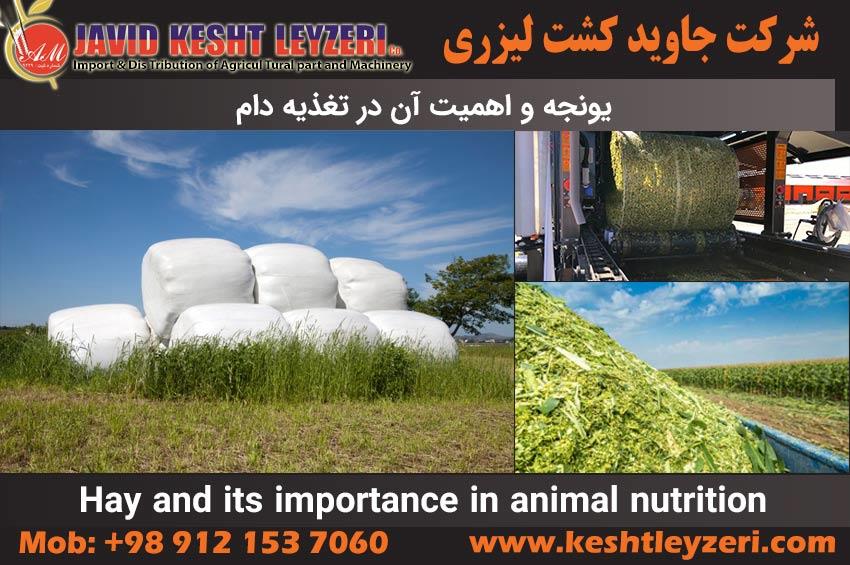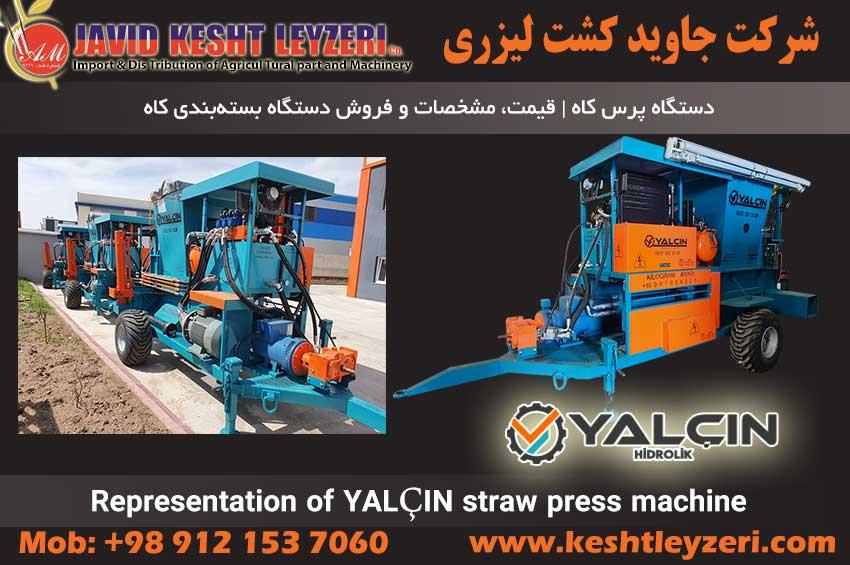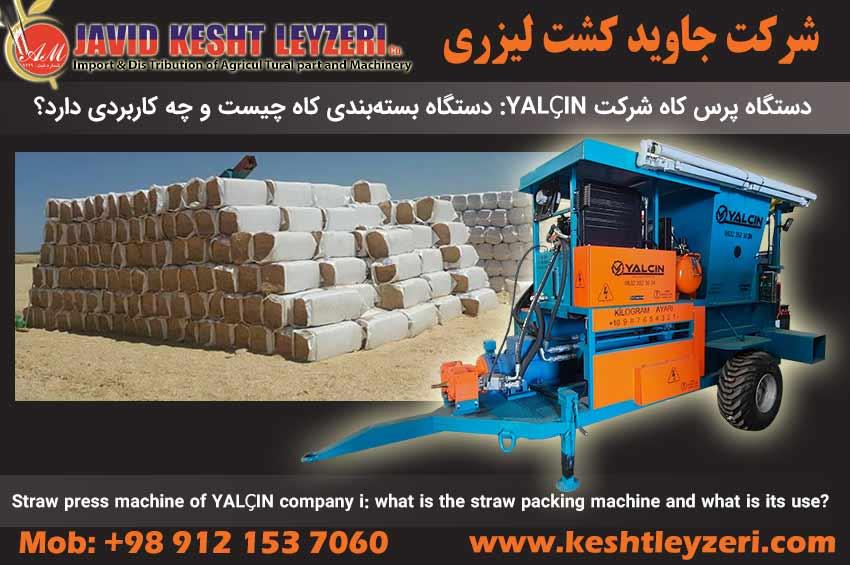
Hay and its importance in animal nutrition
javid keshtleyzeri Co.ltd
Alfalfa is a forage plant that is cultivated in many parts of the world and is used as an important food source for livestock.
Alfalfa plant (Medicago sativa) is a species of leguminous family (Fabaceae). This plant is mainly grown in temperate and cold temperate regions of the world. Alfalfa is very popular for the following reasons:
1. High tolerance against adverse weather conditions
2. Can be produced in low productivity soils
3. Can be used to feed animals
Nutritional value of alfalfa:
1. Protein: The alfalfa plant contains high protein, which is quantitatively and qualitatively superior to other livestock grasses. The protein present in one kilogram of a dry subsidized salt includes one hundred to one hundred and twenty kilograms of pure protein.
2. Vitamins: Alfalfa contains various vitamins, including vitamin C, beta-carotene, thiamin (B1), riboflavin (B2), niacin (B3) and pantothenic acid.
3. Minerals: Alfalfa plant contains significant amounts of calcium, phosphorus, potassium and magnesium.
4. Fibers: one dry pellet machine covers 100 to 120 kilograms of dry fiber.
5. Digestible: alfalfa plant is very suitable for lactating animals due to the presence of indigestible proteins contained in dry greens.
6. Medicinal effects: Hay plant is used as anti-diarrhea, anti-fever, anti-convulsant and sedative.
7. Use in agriculture: alfalfa is used as a feed plant for livestock and also as a cultivated plant for the production of fodder and human food.
8. Positive impact on the soil: Alfalfa plant has the ability to fix nitrogen in the air, and with this, it helps to improve the nitrogen level of the soil. Also, the growth of this plant increases the volume and surface of the soil, which leads to the improvement of the soil structure and prevents soil erosion.
9. Use in human nutrition: The young leaves of the plant are a suitable food source for humans when cooked, and in some geographical countries, hemp seeds are used as a popular and useful food for humans.
10. Use in pharmaceuticals: Some researches have shown that alfalfa plant has anti-inflammatory, anti-cancer and anti-oxidant properties and may be effective in treating some diseases such as cancer, joint inflammation and cardiovascular diseases.
What are the nutritional properties of alfalfa?
This plant has very diverse and useful nutritional properties, which generally include the following:
1. Protein: Hay has a high level of protein and is known as an excellent source of protein for livestock. Protein in animal nutrition is essential for growth, milk production, meat production and maintaining muscle health.
2. Vitamins: alfalfa flowers contain vitamins C, E and K. These vitamins play an important role in the health of animals. In addition, a series of vitamins strengthen the animal's immune system.
3. Minerals: Hay contains large amounts of minerals including calcium, phosphorus, potassium and manganese. These minerals are necessary for building bones, muscle growth and maintaining the balance of electrolytes in the body of animals.
4. Fiber: Fodder plants are very important as a source of fiber for proper feeding of animals. Dried and dried flowers are used as a source of fiber in rose water.
5. Amino acids: The alfalfa plant contains all the amino acids necessary for the growth and health of livestock. These amino acids play a key role in building proteins in the body.
6. Digestibility: Alfalfa has high digestibility and is easily digested by animals as it is used as animal feed. This high digestibility makes the nutrients in hay completely absorbed and used for the growth and production of livestock.
7. Health effects: Alfalfa plant has strong anti-inflammatory and antioxidant properties that can help the general health of livestock. These characteristics reduce the risk of inflammatory diseases and bacterial infections in livestock.
8. Effect on growth: Alfalfa plant contains sensitive nutrients for the growth and production of livestock. The use of dried flowers of Chobein and dried flowers of Chobein in feeding livestock leads to faster growth and improvement of their productive performance...
9. Cost reduction: due to its high nutritional properties and high digestibility, alfalfa can help reduce animal feeding costs. The use of alfalfa plant in livestock diet may require the use of less nutritional supplements...
10. Protecting the environment: alfalfa plant can grow in dry conditions and draw power from water sources. These characteristics make the cultivation of alfalfa as a suitable alternative for water plants in dry and low water areas and help to preserve water resources and preserve the environment.
Therefore, alfalfa plant with proper nutrition can improve the general health of livestock, their better growth and production, reduce the cost of feeding and preserve the environment. The use of alfalfa in feeding livestock can help reduce feeding costs and at the same time improve the general health of livestock. Also, the alfalfa plant has the ability to grow in dry conditions and draw power from water sources, which makes it possible to preserve water sources and help preserve the environment.
The leaf-to-stem ratio is one of the factors that determine the race of this plant. 50% of the protein content of the aerial part of alfalfa was in the leaves. In the alfalfa plant, the leaves make up almost a third of the dry matter. they give. While in terms of food, they include two thirds of it
3- Growth stage at harvest time
The growth stage is the most important factor influencing the alfalfa plant composition. As the plant ages, its need for structural tissues increases, and as a result, the amount of structural carbohydrates (cellulose, hemicellulose, and lignin) increases and the amount of protein decreases.
4- Soil fertility and characteristics
The composition and nutritional value of fodder species changes under the influence of soil type. Alfalfa to the fertile soil along with the soil for Bunjeh is 65. Alfalfa needs a very high pH, the optimal pH level can be planted with sufficient amounts of mineral elements and light and acidic soils and satisfactory fodder can be obtained. In addition, the cultivation of alfalfa in such soils increases their fertility and improves their structure. Many minerals, including zinc, manganese, nickel and cobalt, are more absorbable for alfalfa, which is grown at a low PH alfalfa. In contrast, other minerals, especially molybdenum and selenium, can be absorbed in soils with a higher pH
5- The effects of climate, season and weather on alfalfa compounds
The four factors of plant age, temperature, light intensity and fertilizer affect the formation of fibers and the ability of alfalfa. Increasing the temperature of the plant increases the formation of lignin and reduces the digestibility. Increasing the intensity of light and nitrogen fertilizer increases the digestibility and the amount of wall Reduces cellular
6- The time and season of harvesting hay
Investigations have shown that the growth stage at the time of harvest has a greater effect on the quality of alfalfa than any other factor. In plants such as alfalfa, which have a completely different growth pattern than that of cycads, rapid changes occur during plant maturity and flowering. In a research, the amount of crude protein of alfalfa in the second layer based on dry matter is presented as follows: alfalfa at the beginning of budding stage 5.21, full budding 4.19, beginning of flowering 7.18, mid-flowering 1.17, full flower 9.15 Full flowering has reached 13.6%. The best time to harvest alfalfa in the first field is at the time of flowering, and in the second and third fields, when the alfalfa field has reached 10% flowering.
7- Nutritional value of hay
The nutritional value of alfalfa is more than other fodder plants, if the ratio of energy to protein is lower. Alfalfa in every country has different stages of growth, and its chemical composition differs in each stage from the previous and subsequent stages. On the other hand, the chemical composition of leaves and stems is also different. It means that its leaf is much more valuable than its stem. Alfalfa is a plant rich in calcium. But its phosphorus is average, so if we want to consume a large amount of this food, phosphorus should be added to maintain the balance of calcium. Animals eat a lot of hay that has flowered or is at the end of flowering, with a loss of appetite. The reason for this is the increase in the percentage of raw fibers at the end of flowering and the plant becoming hard and woody, second. The existence of bitter substances as well as saponin and a type of alkanide for legumes in it, they know that the best time to harvest hay depends on the purpose of its use, if you want high quality hay to be sold, for example, to feed dairy cows.
Harvesting hay should be done at budding stage or earlier (28 days period or less), but if you plan to feed fattening calves (high quality hay is not considered) (hay should be harvested at 2550% flowering time (period of 42-42 53 days (harvest until the maximum yield is obtained. When alfalfa in the budding stage of your fodder production is 20-30% less, but in terms of protein and nutritional value, it is more than when it is picked in the middle of the flowering stage.
harvest time
Hay harvesting date has a significant effect on the amount of nutrients, yield and durability of the plant. Before flowering, alfalfa has more protein and digestible nutrients. At the time of complete flowering and seeding, its fiber content increases and digestible substances decrease. In contrast, performance increases. On the other hand, harvesting before flowering and with short intervals weakens the plant and reduces its life because the plant does not get enough time to transfer stored materials from the aerial parts to the roots. Therefore, the best date to harvest alfalfa to obtain the maximum yield of fodder, with High nutritional value (the maximum amount of protein per hectare, along with creating the conditions to provide the maximum amount of food in the following years, when some of the field's buds are in flower.
If alfalfa is harvested frequently and at short intervals, the root's carbon dioxide reserves will be exhausted and the plant will die. Is. After each fold, if the harvesting time is at the beginning of flowering, the amount of root reserves is normal, and due to aerial growth, the root reserves are gradually reduced. When the height of the plant reaches 30 cm, the root reserves reach the minimum. As growth continues and photosynthesis increases, the amount of root reserves also increases gradually. Even at the time of flower bud formation, these reserves are lower than normal. At the beginning of flowering, the root reserves will reach normal again and it is better to harvest hay at this stage.
The following table shows the status of dry matter and quality of alfalfa at different growth ages, which is a recommendation for when to harvest alfalfa:
Evaluation of growth percentage growth stages
Too much protein, dry matter and low cellulose, should not be picked 15-18 before budding
High protein, dry matter and low cellulose, it is better not to pick 20-21 Bud before flower
Nutrient balance depends on proper performance, the best picking time is 22-23, the beginning of flowering.
Relatively little protein, it is better to harvest as soon as possible. 23-25 Full flowering
Low protein, too much dry matter and cellulose, too late to pick 25 after flowering
After harvest, alfalfa begins to regrow almost immediately, but then gradually regains its carbon reserves.
So, in short, it can be said that the factors affecting the nutritional value of alfalfa are:
1. Chemical compounds: Hay contains various chemical compounds that are used as food sources for animals. These ingredients include protein, carbohydrates, fat, and vitamins and minerals. These compounds independently and their groups will increase the nutritional value of the desired product.
2. Moisture level: The moisture level in hay is very important. High humidity in alfalfa will significantly reduce its nutritional value.
3. Harvesting age: Harvesting age plays a significant role in the quality and value of alfalfa food. As alfalfa undergoes chemical and physical changes with age, its nutritional value also changes.
4. Drying method: The drying method plays an important role in increasing or decreasing the nutritional value of alfalfa. For example, drying using high heat may lead to disruption and conversion of some proteins into digestible ones.
5. Storage conditions: Storage conditions play a significant role in maintaining the nutritional value of alfalfa. Factors such as storage temperature, relative humidity, and atmospheric conditions may cause changes in chemical composition and significant loss in alfalfa nutritional value.
6. Fertilization regime: proper fertilization regime increases the quality and nutritional value of hay. Fertilizers containing nitrogen, phosphorus and potassium are used as the main nutrients in the growth and nutrition of plants. Defects in any of these elements may reduce the percentage of protein, vitamins, and minerals in hay. Therefore, the proper use of fertilizers in order to meet the nutritional needs of alfalfa plants, improves the efficiency of greenhouse growth and nutrition, and as a result, increases the nutritional value of the spare parts of the product, such as flowers and leaves.
What are the factors affecting the nutritional value of alfalfa?
Factors affecting the nutritional value of alfalfa
1- Species, variety and strain of the plant
The chemical composition and nutritional value of dry alfalfa is somewhat related to the species and strain of the plant. Different cultivars of alfalfa grown under the same conditions contain very different levels of one or more types of minerals.
2- Leaf to stem ratio






